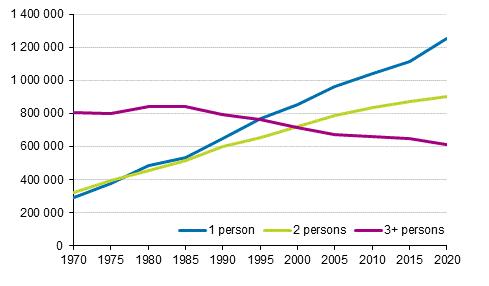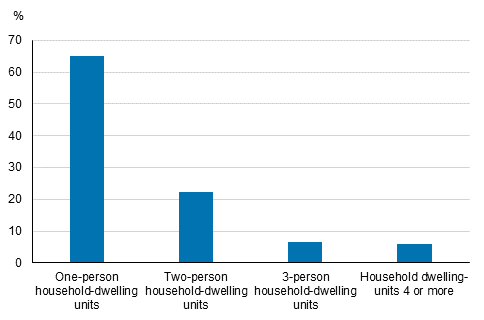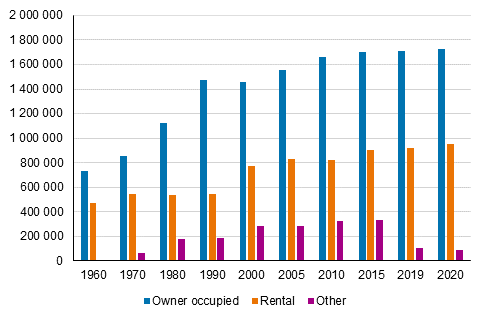2. Household-dwelling units and housing conditions 2020
Average size of a household-dwelling unit 1.96 persons
The number of household-dwelling units with one and two persons has been growing for several decades, being 78 per cent of all household-dwelling units at the end of 2020. At the end of 2020, the total number of household-dwelling units was 2,767,000, of which 1,254,000, i.e. 45 per cent, were single-person household-dwelling units. In 2020 the average size of a household dwelling unit was less than two persons, while in 1970 it was still three persons.
Figure 2. Number of household-dwelling units by size in 1970–2020, number

The size of a household-dwelling unit varied regionally. In urban municipalities the average size of a household-dwelling unit was 1.92 persons and in rural municipalities 2.04 persons. The structure of household-dwelling units differs between rural and urban areas. The share of one-person household-dwelling units is larger in urban areas (47%) than in rural areas (41%).
Around one half of Finns live in detached houses
Around one half of Finns live in detached houses, although only 38 per cent of permanently occupied dwellings are in detached houses. Terraced houses had 375,000 occupied dwellings, that is, 14 per cent of the dwelling stock. Of all occupied dwellings 47 per cent were in blocks of flats, although one third of the population live in blocks of flats. The explanation is that dwellings are smaller in blocks of flats, so smaller families or household-dwelling units live in them than in terraced or detached houses.Table 2. Household-dwelling units and persons by type of building in 2020
| Type of building | Household-dwelling units | % | Persons | % |
| Buildings total | 2 766 679 | 100 | 5 411 922 | 100 |
| Detached and semi-detached houses | 1 055 778 | 38,2 | 2 599 728 | 48,0 |
| Attached houses | 374 670 | 13,5 | 716 105 | 13,2 |
| Blocks of flats | 1 294 260 | 46,8 | 2 027 141 | 37,5 |
| Other buildings | 41 971 | 1,5 | 68 948 | 1,3 |
One household-dwelling unit had around 81 square metres of living area at its disposal, or 41 square metres per person. The floor area per person diminishes considerably as the size of the household-dwelling unit grows. The average area available for a single person living alone was 60 square metres, a two-person household-dwelling unit had 45 square metres per person but a household-dwelling unit of six persons had no more than 21 square metres of floor area per person.
Table 3. Floor area per person (m2) by size of household-dwelling unit in 1985–2020
| Year | Number of persons | |||||||
| All household-dwelling units | 1 person | 2 persons | 3 persons | 4 persons | 5 persons | 6 persons | 7+ persons | |
| 1985 | 28,9 | 48,6 | 34,3 | 27,6 | 24,1 | 21,2 | 18,7 | 15,2 |
| 1990 | 31,4 | 51,8 | 37,0 | 29,4 | 25,0 | 21,7 | 19,0 | 14,8 |
| 1995 | 33,4 | 54,0 | 39,2 | 30,4 | 25,3 | 21,9 | 19,0 | 15,0 |
| 2000 | 35,3 | 55,6 | 40,8 | 31,4 | 26,0 | 22,5 | 19,4 | 15,4 |
| 2005 | 37,5 | 57,0 | 42,4 | 32,3 | 27,3 | 23,7 | 20,4 | 16,3 |
| 2010 | 39,1 | 58,6 | 43,6 | 33,0 | 28,2 | 24,4 | 21,0 | 16,9 |
| 2015 | 40,1 | 59,8 | 44,3 | 33,4 | 28,3 | 24,6 | 21,0 | 16,9 |
| 2016 | 40,3 | 60,0 | 44,4 | 33,5 | 28,3 | 24,5 | 21,0 | 16,8 |
| 2017 | 40,5 | 59,9 | 44,6 | 33,6 | 28,3 | 24,5 | 20,9 | 16,8 |
| 2018 | 40,8 | 59,8 | 44,8 | 33,6 | 28,4 | 24,5 | 20,8 | 16,8 |
| 2019 | 41,0 | 59,8 | 45,0 | 33,7 | 28,4 | 24,4 | 20,8 | 16,8 |
| 2020 | 41,3 | 59,8 | 45,2 | 33,8 | 28,4 | 24,4 | 20,8 | 16,9 |
Almost one in five Finns lives in an overcrowded dwelling
At the end of 2020, the number of household-dwelling units living in overcrowded dwellings was 210,000 and the total number of persons living in such dwellings was 870,000. A household-dwelling unit is defined as living in an overcrowded dwelling if it consists of more than one person per one room of its dwelling, so a person living alone cannot be regarded as living in an overcrowded dwelling. 16 per cent of housing population lived in an overcrowded dwelling. In 2020 the number of overcrowded household-dwelling units has again decreased by around 4,900 and the number of persons living in overcrowded dwellings decreased by around 21,100.
Owner-occupied dwellings have more living space than rented dwellings, when measured by floor area per person. The average floor area per persons of a household-dwelling unit living in an owner-occupied dwelling is 45 square metres, while a unit living in a rented dwelling has only 33 square metres of floor area per person.
Of rental dwellings, non-subsidised rented dwellings had the most floor area per person, 34 square metres. Differences to other rental dwellings were not large. In government-subsidised rented dwellings the floor area was 32 square metres per person. In right-of-occupancy dwellings the living space per person was 34 square metres.
Mainly household-dwelling units of one to two persons in rented dwellings
The majority of those living in rented dwellings, 87 per cent, were living alone or together with another person, while in owner-occupied dwellings the corresponding share was 73 per cent. Six per cent of the household-dwelling units living in rented dwellings and 16 per cent of those living in owner-occupied dwellings were larger household-dwelling units with at least four persons. At the end of 2020, the number of permanently occupied rented dwellings was around 953,000, and 304,000 were government-subsidised or interest-subsidised rented dwellings and 649,000 dwellings were privately financed.Figure 3. Rented dwellings by size of household-dwelling unit in 2020, (%)

In all, 2,767,000 dwellings were permanently occupied at the end of 2020. Over one half of good one million permanently occupied dwellings in blocks of flats were rented dwellings. Around 122,000 dwellings were rented in terraced houses, being about one third of occupied dwellings in terraced houses. Detached and semi-detached houses had 39,000 rented dwellings.
One quarter of the population live in rented dwellings
The proportion of rented dwellings of all permanently occupied dwellings was 34 per cent, 1.5 million, more than one quarter of the population, lived in rented dwellings. In rented dwellings there are smaller household-dwelling units than in owner-occupied dwellings. At the end of 2020, the total number of permanently occupied rental dwellings was around 953,000, of which 32 per cent were government-subsidised or interest-subsidised rental dwellings. The share of government-subsidised or interest-subsidised rental dwellings of all permanently occupied rental dwellings decreased, as dwellings freed from restrictions. And that is part of the reason why other rental dwellings has increased. At the end of 2020, there were 49,000 right-of-occupancy permanently occupied dwellings in Finland. Forty-six per cent of them are located in Greater Helsinki.
Figure 4. Dwellings by tenure status in 1960–2020.

Renting is a tenure status preferred by young household-dwelling units in particular. As the age of the oldest person of a household-dwelling unit goes up the proportion of those living in rented dwellings goes down. In all, 79 per cent of the household-dwelling units with the oldest person aged under 30 and 40 per cent of those with the oldest persons aged 30 to 44 lived in rented dwellings, while only 24 per cent of the household-dwelling units where the oldest person was aged 45 to 74 did so. The household-dwelling units where the oldest person was aged 45 to 74 were the most likely to own their house. Forty-three per cent of the households-dwelling units meeting this age criterion were owner-occupiers of detached houses. In contrast, when the oldest person in the household-dwelling unit was older than this, owning a house was less likely. The most common mode of dwelling at a later stage in life was an owner-occupied flat in a housing company.
Source: Dwellings and Housing Conditions, Statistics Finland
Inquiries: Mika Ronkainen 029 551 3425, Anu Rämö 029 551 3450, info@stat.fi
Head of Department in charge: Hannele Orjala
Updated 14.10.2021
Official Statistics of Finland (OSF):
Dwellings and housing conditions [e-publication].
ISSN=1798-6761. Overview 2020,
2. Household-dwelling units and housing conditions 2020
. Helsinki: Statistics Finland [referred: 16.1.2026].
Access method: http://stat.fi/til/asas/2020/01/asas_2020_01_2021-10-14_kat_002_en.html

